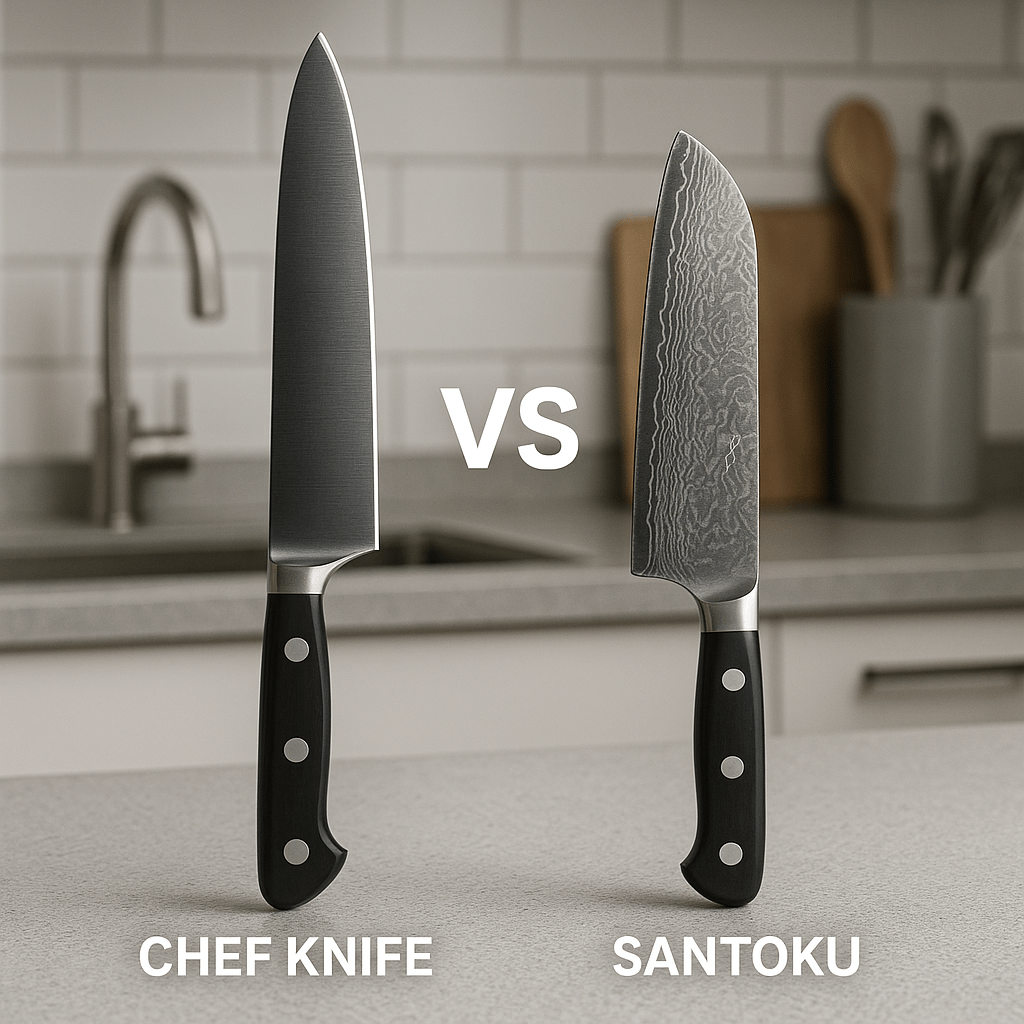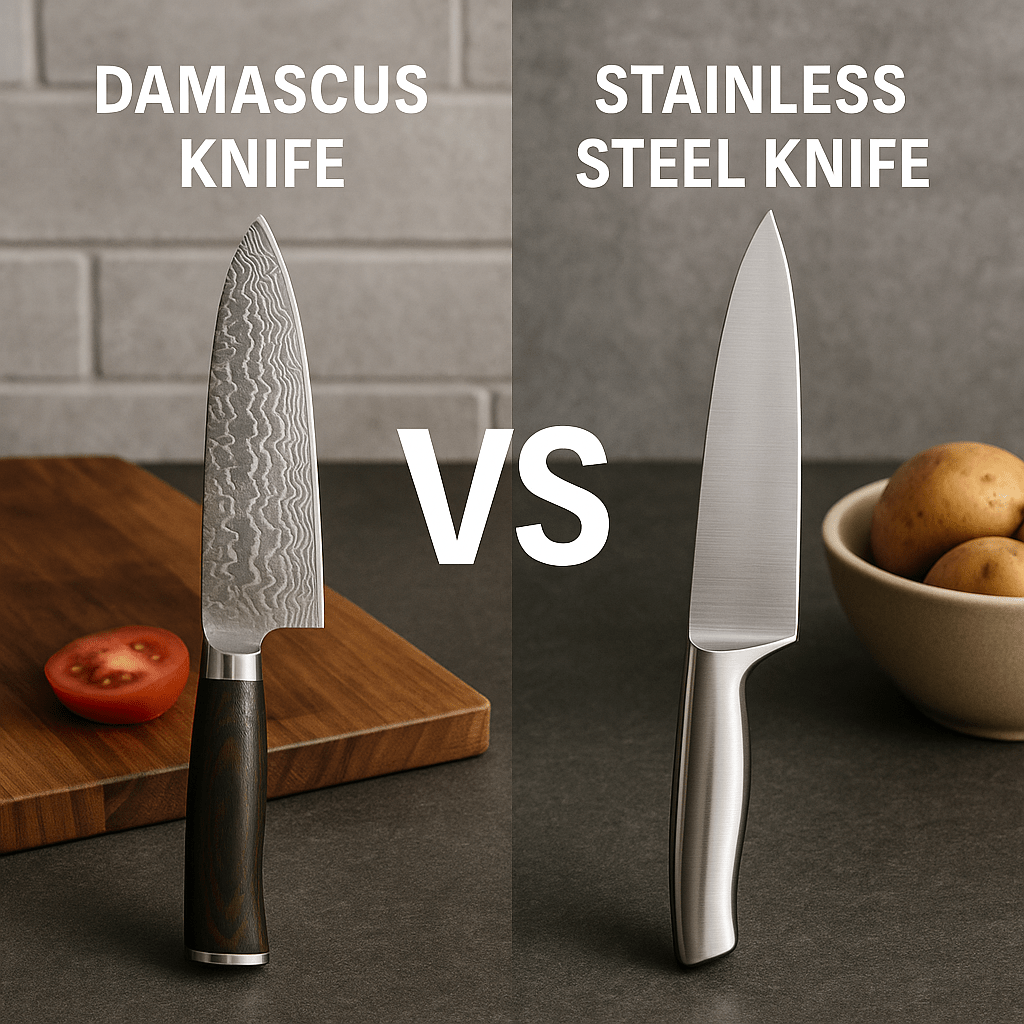
Chef Knife vs Santoku Knife – Which Should You Choose?
The chef knife (often called a Gyuto in Japanese styles) and the Santoku knife are two of the most widely used kitchen knives in the world. Both are versatile, both can be a “one-knife solution,” yet their differences can dramatically affect how you cook. This guide takes a closer look at their history, design, cooking applications, and expert recommendations.
History and Cultural Background
The Chef Knife (Gyuto)
The chef knife originated in Europe, particularly France and Germany. It was developed to be a do-it-all tool—capable of slicing meat, chopping vegetables, and performing fine detail work. When Japanese makers adopted the style, they created the Gyuto, a thinner, sharper version designed for Japanese cuisine. Today, the chef knife is a staple in both Western and Asian kitchens.
The Santoku Knife
The Santoku, meaning “three virtues,” emerged in Japan during the mid-20th century. The “three virtues” are often interpreted as meat, fish, and vegetables, reflecting its balanced versatility. With a shorter blade and flatter profile than a chef knife, it became the go-to knife for home kitchens in Japan, particularly where cutting boards and spaces were smaller.
Blade Design and Geometry
| Feature | Chef Knife (Gyuto) | Santoku Knife |
|---|---|---|
| Length | 8–10 inches (20–25 cm) | 6–7 inches (16–18 cm) |
| Edge Profile | Curved belly for rocking motion | Flatter edge for push cuts |
| Tip Shape | Pointed, ideal for piercing and detail | Sheep’s foot, safer and more compact |
| Steel Hardness | HRC 58–61 (German steel softer, Japanese Gyuto harder) | HRC 59–61 (often Damascus or VG-10 steel) |
| Weight | Medium-heavy, balanced for long slicing | Lighter, nimble in tight spaces |
Cutting Techniques and Cooking Styles
Chef Knife
- Rock chopping: The curved belly allows a rocking motion, perfect for herbs and garlic.
- Long slicing strokes: Works beautifully on roasts, melons, and large proteins.
- Tip control: The sharp tip is great for trimming fat, deveining shrimp, or coring fruit.
Santoku
- Push cutting: The flat edge makes up-and-down cuts fast and precise.
- Vegetable prep: Excels at carrots, cucumbers, onions, and other produce.
- Compact use: Shorter blade suits smaller kitchens and cutting boards.
Advantages of Chef Knives
- Versatility: Handles meat, fish, and vegetables equally well.
- Precision tip: Allows for detail work and piercing tasks.
- Professional standard: Preferred in restaurant kitchens worldwide.
- Rock chop motion: Intuitive for Western cooks trained in classical technique.
Advantages of Santoku Knives
- Compact size: Easier for smaller hands and tight workspaces.
- Thin blade: Glides through vegetables with minimal resistance.
- Safety: Rounded tip reduces risk of accidents.
- Efficiency: Shorter blade = quicker, more controlled cuts.
Professional Chef Insights
Many chefs recommend having both knives. The chef knife is unbeatable for Western-style cooking and large prep tasks, while the Santoku excels at fast, precise vegetable prep and compact kitchens. Japanese households often rely on Santoku as their primary knife, while Western restaurants favor chef knives. Home cooks can benefit from owning one of each to cover all styles.
Practical Recommendations
- If you rock-chop herbs and cook meat often: Get a chef knife.
- If you mostly prepare vegetables and cook in small spaces: Choose a Santoku.
- If budget allows: Invest in both. Together they form a powerful duo covering all kitchen tasks.
Maintenance and Care
- Chef Knife: Sharpen regularly with a whetstone, avoid bones, hand wash and dry.
- Santoku: Hone often to maintain thin edge, wash immediately, store safely in a sheath or block.
Weekly Deal 🔥
Looking for the perfect all-purpose knife? Explore OSERM’s Japanese Damascus Chef Knives and Santoku Knives—crafted with 67-layer Damascus steel and designed for precision, beauty, and durability.
You Might Also Like
- Gyuto vs Santoku – Japan’s Two Most Popular Knives
- German Knives vs Japanese Knives – Cooking Culture Showdown
- How to Choose Your First Japanese Knife
Tags: chef knife vs santoku, gyuto vs santoku, japanese knife comparison, OSERM






